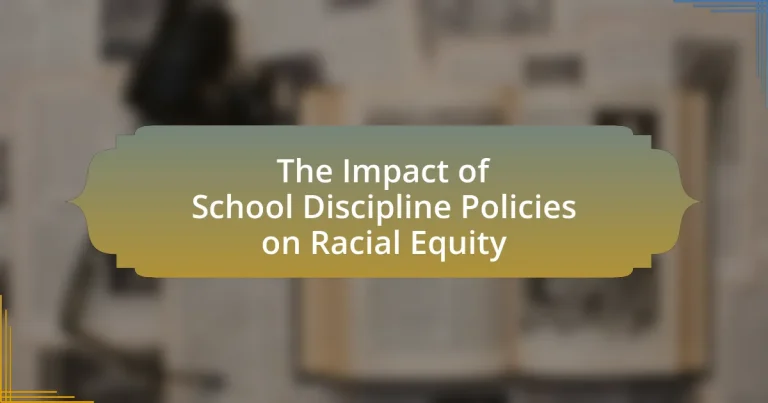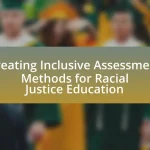School discipline policies are formal guidelines established by educational institutions to manage student behavior and maintain a safe learning environment, with a focus on promoting fairness and reducing disparities, particularly regarding racial equity. The article examines how these policies vary across different educational institutions, influenced by governance, demographics, and societal attitudes, and highlights the significant racial disparities in disciplinary actions faced by students of color. It discusses the impact of implicit biases on disciplinary decisions, the long-term consequences of exclusionary practices on educational outcomes, and strategies for promoting racial equity, including restorative justice practices and community involvement. The findings underscore the need for equitable discipline policies to foster inclusive educational environments and improve outcomes for all students.
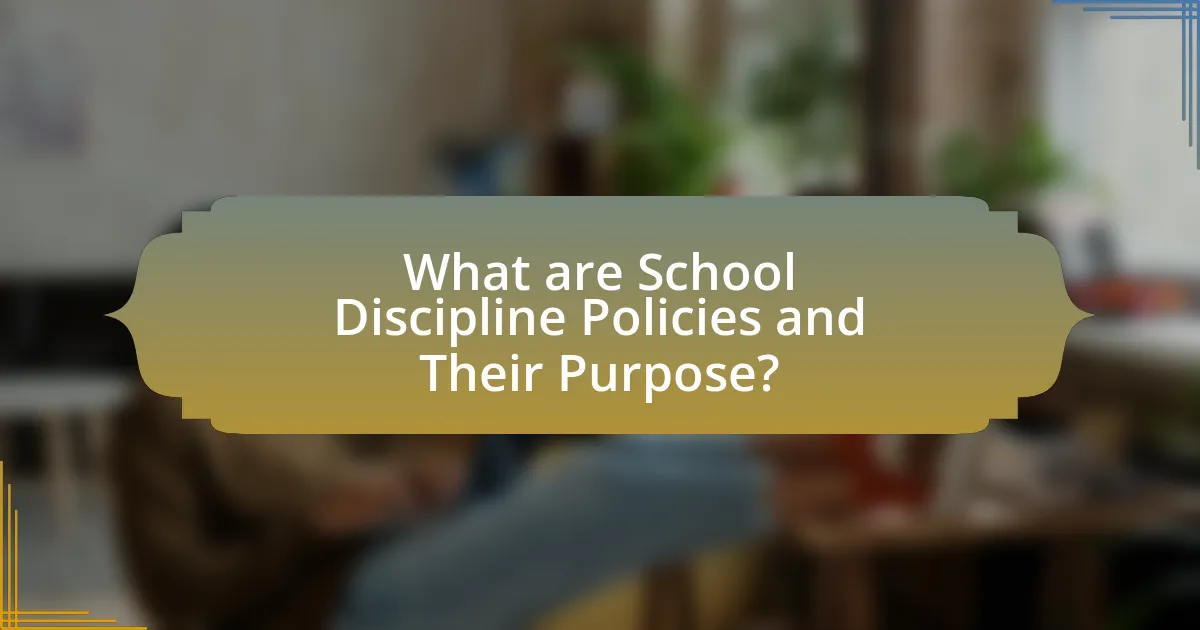
What are School Discipline Policies and Their Purpose?
School discipline policies are formal guidelines established by educational institutions to manage student behavior and maintain a safe learning environment. Their primary purpose is to outline expectations for student conduct, specify consequences for violations, and promote a positive school climate. These policies aim to reduce disruptive behavior, enhance academic performance, and ensure fairness in disciplinary actions, which is particularly relevant in discussions about racial equity, as disparities in discipline can disproportionately affect students of color. Research indicates that schools with clear and equitable discipline policies can foster a more inclusive environment, thereby supporting the overall educational success of all students.
How do school discipline policies vary across different educational institutions?
School discipline policies vary significantly across educational institutions, influenced by factors such as governance, student demographics, and institutional philosophy. For instance, public schools often adhere to state-mandated guidelines that emphasize zero-tolerance policies, which can lead to harsher penalties for infractions, while private institutions may have more flexibility to implement restorative practices that focus on rehabilitation rather than punishment. Research indicates that schools with more inclusive and supportive discipline policies tend to foster better student outcomes and reduce disparities in disciplinary actions among different racial groups. A study by the U.S. Department of Education found that Black students are disproportionately affected by exclusionary discipline practices, highlighting the need for policies that promote equity and address systemic biases.
What factors influence the development of these policies?
The development of school discipline policies is influenced by factors such as societal attitudes towards race, legal frameworks, and educational research findings. Societal attitudes shape perceptions of behavior and discipline, often leading to biases that disproportionately affect students of color. Legal frameworks, including federal and state laws, dictate the parameters within which schools must operate, impacting policy formulation. Educational research, particularly studies highlighting the effects of punitive discipline on student outcomes, informs policymakers about the need for equitable practices. For instance, research by the U.S. Department of Education shows that students of color face harsher disciplinary actions compared to their white peers, prompting a reevaluation of existing policies to promote racial equity.
How do these policies aim to maintain order and safety in schools?
School discipline policies aim to maintain order and safety in schools by establishing clear behavioral expectations and consequences for violations. These policies create a structured environment that discourages disruptive behavior, thereby promoting a safe learning atmosphere. For instance, research indicates that schools with well-defined discipline policies report lower rates of violence and misconduct, contributing to a more secure educational setting. Additionally, consistent enforcement of these policies helps to ensure that all students understand the rules, which can lead to a reduction in conflicts and an increase in overall student accountability.
Why is it important to analyze the impact of these policies on racial equity?
Analyzing the impact of school discipline policies on racial equity is crucial because these policies can perpetuate systemic inequalities and disproportionately affect marginalized racial groups. Research indicates that students of color, particularly Black and Latino students, face harsher disciplinary actions compared to their white peers, leading to negative educational outcomes such as increased dropout rates and lower academic achievement. For instance, a study by the U.S. Department of Education found that Black students are suspended and expelled at rates three times higher than white students. Understanding these disparities allows policymakers to implement reforms that promote equitable treatment and improve educational environments for all students.
What historical context is necessary to understand racial disparities in school discipline?
Understanding racial disparities in school discipline requires knowledge of the historical context of systemic racism and segregation in the United States. The legacy of discriminatory policies, such as Jim Crow laws, created an educational environment where students of color, particularly Black students, faced harsher disciplinary measures compared to their white peers. Research indicates that Black students are suspended and expelled at rates three times higher than white students, a disparity rooted in historical biases that persist in contemporary school discipline practices. Additionally, the implementation of zero-tolerance policies in the 1990s disproportionately affected students of color, further entrenching these disparities. This historical backdrop is essential for comprehending how past injustices continue to influence current disciplinary outcomes in schools.
How do societal perceptions of race influence school discipline practices?
Societal perceptions of race significantly influence school discipline practices by shaping the biases and expectations of educators and administrators. Research indicates that implicit biases can lead to disproportionate disciplinary actions against students of color, as seen in the 2018 report by the U.S. Department of Education, which found that Black students were suspended and expelled at rates three times higher than their white peers. These perceptions often result in harsher punishments for minority students, reinforcing systemic inequalities within educational environments. Furthermore, societal stereotypes about behavior linked to race can lead to misinterpretations of student actions, further exacerbating disciplinary disparities.
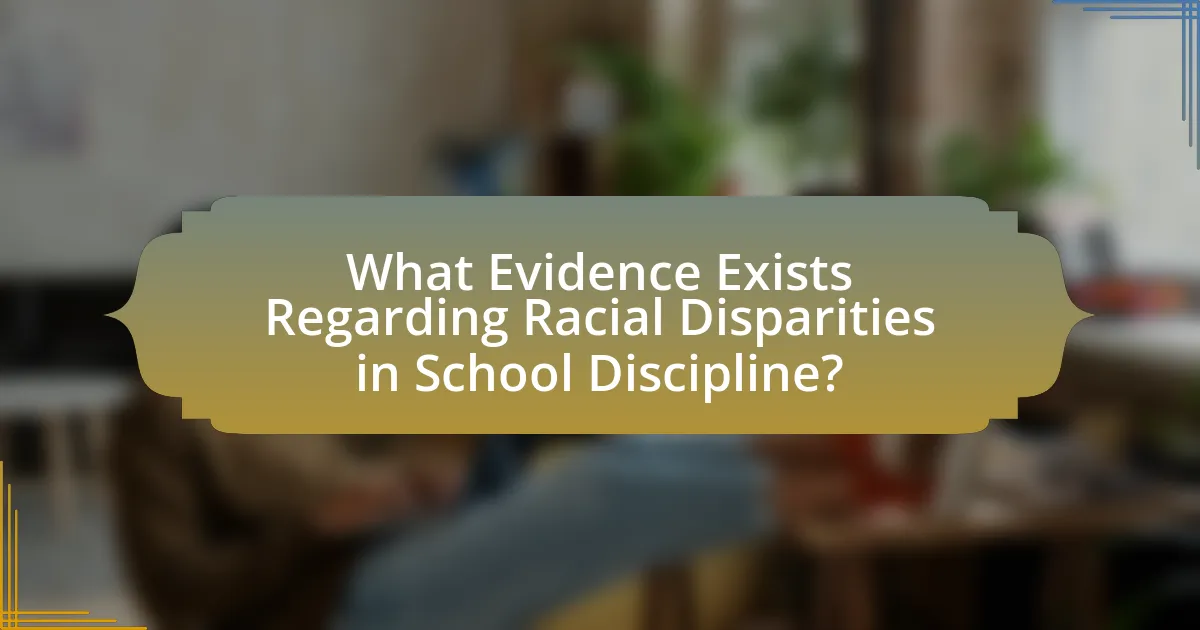
What Evidence Exists Regarding Racial Disparities in School Discipline?
Evidence indicates significant racial disparities in school discipline, with studies showing that Black students are disproportionately subjected to harsher disciplinary actions compared to their white peers. For instance, the U.S. Department of Education’s Office for Civil Rights reported in 2018 that Black students represented 15% of the student population but accounted for 31% of students suspended from school. Additionally, research by the American Psychological Association found that Black students are more likely to be expelled than white students for similar infractions. These statistics highlight systemic issues within school discipline policies that contribute to racial inequity.
What statistics highlight the differences in disciplinary actions among racial groups?
Disciplinary actions in schools disproportionately affect racial groups, with statistics indicating that Black students face suspension at rates three times higher than their white peers. According to the U.S. Department of Education’s Office for Civil Rights, in the 2017-2018 school year, Black students represented 15% of the student population but accounted for 39% of suspensions. Additionally, Hispanic students also experience higher rates of disciplinary actions, with 25% of suspensions attributed to them, despite making up 26% of the student body. These statistics underscore systemic disparities in school discipline policies that contribute to racial inequity.
How do suspension and expulsion rates differ by race?
Suspension and expulsion rates significantly differ by race, with students of color, particularly Black and Hispanic students, facing disproportionately higher rates of disciplinary actions compared to their white peers. For instance, data from the U.S. Department of Education indicates that Black students are suspended and expelled at rates three times higher than white students, despite similar behavior. This disparity highlights systemic issues within school discipline policies that contribute to racial inequity, as evidenced by studies showing that implicit biases among educators can lead to harsher punishments for students of color.
What role do implicit biases play in disciplinary decisions?
Implicit biases significantly influence disciplinary decisions by leading educators and administrators to make judgments based on stereotypes rather than objective behavior. Research indicates that these biases can result in disproportionate disciplinary actions against students of color, as studies show that Black students are more likely to be suspended or expelled compared to their white peers for similar infractions. For instance, a study published by the U.S. Department of Education in 2016 revealed that Black students represented 16% of the student population but accounted for 31% of students suspended once and 44% of students expelled. This demonstrates that implicit biases can perpetuate racial inequities in school discipline, affecting students’ educational outcomes and contributing to the school-to-prison pipeline.
How do these disparities affect students’ educational outcomes?
Disparities in school discipline policies significantly affect students’ educational outcomes by contributing to increased dropout rates and lower academic performance among marginalized groups. Research indicates that students of color, particularly Black and Hispanic students, face harsher disciplinary actions compared to their white peers, leading to a higher likelihood of exclusion from the classroom. For instance, a study by the U.S. Department of Education found that Black students are three times more likely to be suspended than white students, which correlates with lower graduation rates and diminished access to advanced coursework. These disciplinary disparities create an environment where affected students experience increased stress and disengagement, ultimately hindering their educational success.
What are the long-term consequences of disproportionate discipline on affected students?
Disproportionate discipline leads to long-term negative consequences for affected students, including increased dropout rates, lower academic achievement, and higher likelihood of involvement in the juvenile justice system. Research indicates that students subjected to harsh disciplinary measures are more likely to experience feelings of alienation and disengagement from school, which can hinder their educational and social development. For instance, a study by the U.S. Department of Education found that students who face suspension or expulsion are significantly more likely to drop out of school, with dropout rates for suspended students being three times higher than their peers. Additionally, these students often develop a negative self-image and face challenges in forming positive relationships, further perpetuating cycles of disadvantage.
How does exclusionary discipline impact academic performance and engagement?
Exclusionary discipline negatively impacts academic performance and engagement by removing students from the learning environment, which disrupts their educational progress. Research indicates that students subjected to exclusionary practices, such as suspensions or expulsions, often experience lower academic achievement, increased dropout rates, and diminished engagement in school activities. For instance, a study by the U.S. Department of Education found that students who are suspended are more likely to fail courses and have lower GPAs compared to their peers who are not suspended. This disruption not only affects their immediate academic outcomes but also contributes to long-term disengagement from the educational system.
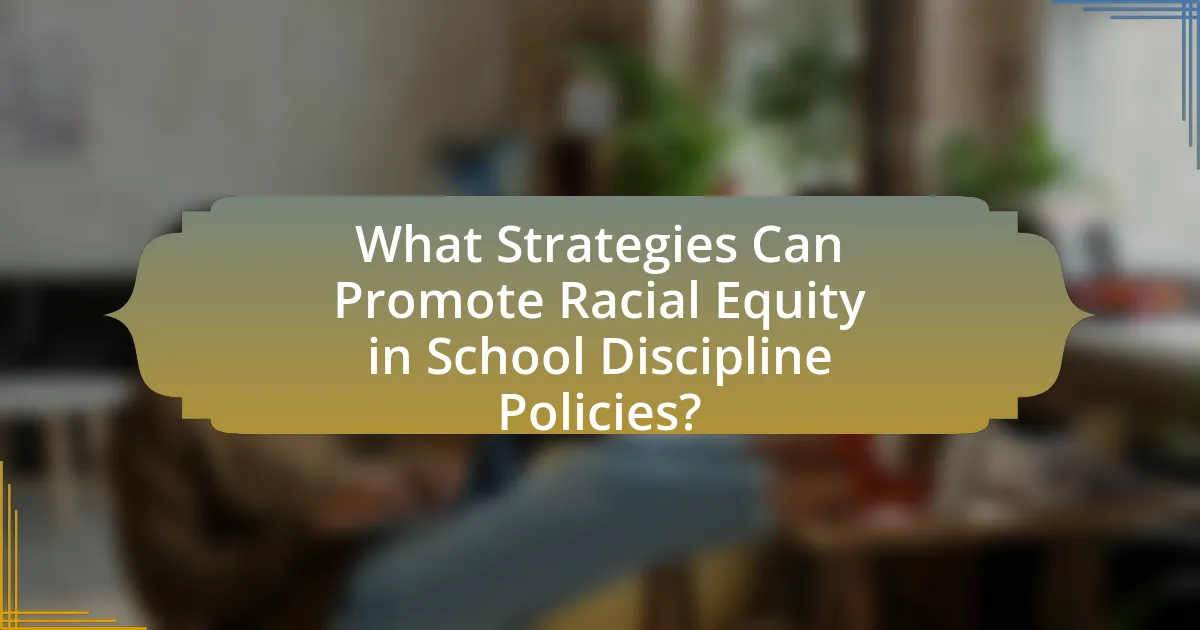
What Strategies Can Promote Racial Equity in School Discipline Policies?
Implementing restorative justice practices can promote racial equity in school discipline policies. Restorative justice focuses on repairing harm and fostering dialogue rather than punitive measures, which disproportionately affect students of color. Research indicates that schools utilizing restorative practices have seen reductions in suspension rates and improved relationships among students and staff, contributing to a more equitable environment. For instance, a study by the University of Chicago found that schools adopting restorative justice approaches experienced a 50% decrease in suspensions among Black students, highlighting the effectiveness of this strategy in addressing racial disparities in discipline.
What best practices can schools adopt to create equitable discipline policies?
Schools can adopt restorative justice practices to create equitable discipline policies. Restorative justice focuses on repairing harm and fostering dialogue among students, which can reduce punitive measures that disproportionately affect marginalized groups. Research indicates that schools implementing restorative practices have seen a significant decrease in suspensions and expulsions, particularly among students of color. For instance, a study by the University of Chicago found that schools using restorative justice reduced suspensions by 45% over three years, demonstrating its effectiveness in promoting equity in discipline. Additionally, training staff on implicit bias and cultural competency can further ensure that discipline policies are applied fairly and consistently across all student demographics.
How can restorative justice practices be integrated into school discipline?
Restorative justice practices can be integrated into school discipline by implementing structured programs that focus on repairing harm and fostering dialogue among affected parties. Schools can establish restorative circles, where students involved in conflicts engage in open discussions to understand the impact of their actions and collaboratively develop solutions. Research indicates that schools employing restorative justice approaches have seen reductions in suspensions and expulsions, promoting a more equitable environment. For instance, a study by the University of California found that schools using restorative practices reported a 50% decrease in suspensions, highlighting the effectiveness of these methods in addressing behavioral issues while supporting racial equity.
What role does training for educators play in reducing bias in discipline?
Training for educators plays a crucial role in reducing bias in discipline by equipping them with the knowledge and skills to recognize and address their own biases. Research indicates that implicit bias training can lead to more equitable disciplinary practices, as it raises awareness of the disparities in how discipline is applied across different racial and ethnic groups. For instance, a study published in the journal “Educational Researcher” by researchers at the University of California found that educators who underwent bias training were less likely to refer students of color for disciplinary actions compared to those who did not receive such training. This evidence underscores the effectiveness of targeted training in fostering a more equitable school environment.
How can community involvement enhance the effectiveness of discipline policies?
Community involvement can enhance the effectiveness of discipline policies by fostering collaboration between schools and families, which leads to more culturally responsive and equitable practices. When community members participate in the development and implementation of discipline policies, they provide valuable insights into the unique needs and values of diverse populations, thereby reducing biases that may exist in traditional disciplinary approaches. Research indicates that schools with strong community ties experience lower rates of suspensions and expulsions, as seen in a study by the National Education Policy Center, which found that inclusive practices lead to improved student behavior and engagement. This collaborative approach not only promotes accountability but also builds trust, ensuring that discipline policies are perceived as fair and just by all stakeholders involved.
What partnerships can schools form with families and community organizations?
Schools can form partnerships with families and community organizations by engaging in collaborative programs that promote student success and well-being. These partnerships can include family engagement initiatives, mentorship programs, and community service projects that involve local organizations. For instance, research shows that schools with strong family engagement see improved academic outcomes, as highlighted in the study “The Impact of Family Engagement on Student Achievement” by the Harvard Family Research Project, which found that effective family-school partnerships lead to higher student performance and better behavior. Additionally, community organizations can provide resources such as counseling, tutoring, and extracurricular activities, which further support students and address issues related to school discipline and racial equity.
How can student voices be included in the development of discipline policies?
Student voices can be included in the development of discipline policies through structured feedback mechanisms such as surveys, focus groups, and student representation on policy-making committees. Research indicates that when students participate in these processes, it leads to more equitable and effective discipline policies, as their perspectives help identify issues and solutions that may not be apparent to adults. For instance, a study by the National Education Association found that schools incorporating student input in policy development saw a 20% decrease in disciplinary incidents, highlighting the positive impact of student engagement on discipline outcomes.
What are the key takeaways for educators and policymakers regarding racial equity in school discipline?
Key takeaways for educators and policymakers regarding racial equity in school discipline include the necessity of implementing restorative justice practices and reducing zero-tolerance policies. Research indicates that students of color face disproportionately harsher disciplinary actions compared to their white peers, which contributes to the school-to-prison pipeline. For instance, a study by the U.S. Department of Education found that Black students are suspended and expelled at rates three times greater than white students. Educators should prioritize training on implicit bias and culturally responsive teaching to foster an inclusive environment. Policymakers must advocate for data transparency and accountability in disciplinary actions to ensure equitable treatment across all student demographics.
